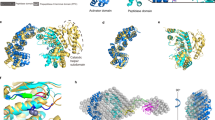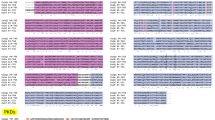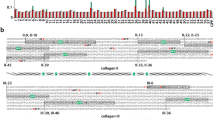Abstract
Collagen constitutes one-third of body protein in humans, reflecting its extensive role in health and disease. Of similar importance, therefore, are the idiosyncratic proteases that have evolved for collagen remodeling. The most efficient collagenases are those that enable clostridial bacteria to colonize their host tissues; but despite intense study, the structural and mechanistic basis of these enzymes has remained elusive. Here we present the crystal structure of collagenase G from Clostridium histolyticum at 2.55-Å resolution. By combining the structural data with enzymatic and mutagenesis studies, we derive a conformational two-state model of bacterial collagenolysis, in which recognition and unraveling of collagen microfibrils into triple helices, as well as unwinding of the triple helices, are driven by collagenase opening and closing.
This is a preview of subscription content, access via your institution
Access options
Subscribe to this journal
Receive 12 print issues and online access
$189.00 per year
only $15.75 per issue
Buy this article
- Purchase on Springer Link
- Instant access to full article PDF
Prices may be subject to local taxes which are calculated during checkout




Similar content being viewed by others

References
Ottani, V., Martini, D., Franchi, M., Ruggeri, A. & Raspanti, M. Hierarchical structures in fibrillar collagens. Micron 33, 587–596 (2002).
Brozek, J., Grande, F., Anderson, J.T. & Keys, A. Densitometric analysis of body composition: revision of some quantitative assumptions. Ann. NY Acad. Sci. 110, 113–140 (1963).
Sweeney, S.M. et al. Candidate cell and matrix interaction domains on the collagen fibril, the predominant protein of vertebrates. J. Biol. Chem. 283, 21187–21197 (2008).
Bond, M.D. & Van Wart, H.E. Purification and separation of individual collagenases of Clostridium histolyticum using red dye ligand chromatography. Biochemistry 23, 3077–3085 (1984).
Matsushita, O. et al. A study of the collagen-binding domain of a 116-kDa Clostridium histolyticum collagenase. J. Biol. Chem. 273, 3643–3648 (1998).
Borkakoti, N. et al. Structure of the catalytic domain of human fibroblast collagenase complexed with an inhibitor. Nat. Struct. Biol. 1, 106–110 (1994).
Li, J. et al. Structure of full-length porcine synovial collagenase reveals a C-terminal domain containing a calcium-linked, four-bladed beta-propeller. Structure 3, 541–549 (1995).
Stams, T. et al. Structure of human neutrophil collagenase reveals large S1′ specificity pocket. Nat. Struct. Biol. 1, 119–123 (1994).
Iyer, S., Visse, R., Nagase, H. & Acharya, K.R. Crystal structure of an active form of human MMP-1. J. Mol. Biol. 362, 78–88 (2006).
Adhikari, A.S., Chai, J. & Dunn, A.R. Mechanical load induces a 100-fold increase in the rate of collagen proteolysis by MMP-1. J. Am. Chem. Soc. 133, 1686–1689 (2011).
Han, S. et al. Molecular mechanism of type I collagen homotrimer resistance to mammalian collagenases. J. Biol. Chem. 285, 22276–22281 (2010).
Minond, D., Lauer-Fields, J.L., Nagase, H. & Fields, G.B. Matrix metalloproteinase triple-helical peptidase activities are differentially regulated by substrate stability. Biochemistry 43, 11474–11481 (2004).
Chung, L. et al. Collagenase unwinds triple-helical collagen prior to peptide bond hydrolysis. EMBO J. 23, 3020–3030 (2004).
Tam, E.M., Moore, T.R., Butler, G.S. & Overall, C.M. Characterization of the distinct collagen binding, helicase and cleavage mechanisms of matrix metalloproteinase 2 and 14 (gelatinase A and MT1-MMP): the differential roles of the MMP hemopexin C domains and the MMP-2 fibronectin type II modules in collagen triple helicase activities. J. Biol. Chem. 279, 43336–43344 (2004).
Fecteau, K.A., Haffner, J.C. & Eiler, H. The potential of collagenase as a new therapy for separation of human retained placenta: hydrolytic potency on human, equine and bovine placentae. Placenta 19, 379–383 (1998).
Shi, L. & Carson, D. Collagenase Santyl ointment: a selective agent for wound debridement. J. Wound Ostomy Continence Nurs. 36, S12–S16 (2009).
Hesse, F., Burtscher, H., Popp, F. & Ambrosius, D. Recombinant enzymes for islet isolation: purification of a collagenase from Clostridium histolyticum and cloning/expression of the gene. Transplant. Proc. 27, 3287–3289 (1995).
Ducka, P. et al. A universal strategy for high-yield production of soluble and functional clostridial collagenases in E. coli. Appl. Microbiol. Biotechnol. 83, 1055–1065 (2009).
Wilson, J.J., Matsushita, O., Okabe, A. & Sakon, J. A bacterial collagen-binding domain with novel calcium-binding motif controls domain orientation. EMBO J. 22, 1743–1752 (2003).
Groves, M.R. & Barford, D. Topological characteristics of helical repeat proteins. Curr. Opin. Struct. Biol. 9, 383–389 (1999).
Kyrieleis, O.J., Goettig, P., Kiefersauer, R., Huber, R. & Brandstetter, H. Crystal structures of the tricorn interacting factor F3 from Thermoplasma acidophilum, a zinc aminopeptidase in three different conformations. J. Mol. Biol. 349, 787–800 (2005).
Thunnissen, M.M., Nordlund, P. & Haeggstrom, J.Z. Crystal structure of human leukotriene A4 hydrolase, a bifunctional enzyme in inflammation. Nat. Struct. Biol. 8, 131–135 (2001).
Matthews, B.W., Jansonius, J.N., Colman, P.M., Schoenborn, B.P. & Dupourque, D. Three-dimensional structure of thermolysin. Nat. New Biol. 238, 37–41 (1972).
Jung, C.M. et al. Identification of metal ligands in the Clostridium histolyticum ColH collagenase. J. Bacteriol. 181, 2816–2822 (1999).
Wang, Y.K. et al. Mechanistic insight into the function of the C-terminal PKD domain of the collagenolytic serine protease deseasin MCP-01 from deep sea Pseudoalteromonas sp. SM9913: binding of the PKD domain to collagen results in collagen swelling but does not unwind the collagen triple helix. J. Biol. Chem. 285, 14285–14291 (2010).
Sanchez-Lopez, R., Alexander, C.M., Behrendtsen, O., Breathnach, R. & Werb, Z. Role of zinc-binding- and hemopexin domain-encoded sequences in the substrate specificity of collagenase and stromelysin-2 as revealed by chimeric proteins. J. Biol. Chem. 268, 7238–7247 (1993).
Vallee, B.L. & Auld, D.S. Zinc coordination, function, and structure of zinc enzymes and other proteins. Biochemistry 29, 5647–5659 (1990).
Eckhard, U. et al. Biochemical characterization of the catalytic domains of three different Clostridial collagenases. Biol. Chem. 390, 11–18 (2009).
Mookhtiar, K.A., Steinbrink, D.R. & Van Wart, H.E. Mode of hydrolysis of collagen-like peptides by class I and class II Clostridium histolyticum collagenases: evidence for both endopeptidase and tripeptidylcarboxypeptidase activities. Biochemistry 24, 6527–6533 (1985).
Hu, Y. et al. Rapid determination of substrate specificity of Clostridium histolyticum beta-collagenase using an immobilized peptide library. J. Biol. Chem. 277, 8366–8371 (2002).
French, M.F., Bhown, A. & Van Wart, H.E. Identification of Clostridium histolyticum collagenase hyperreactive sites in type I, II, and III collagens: lack of correlation with local triple helical stability. J. Protein Chem. 11, 83–97 (1992).
French, M.F., Mookhtiar, K.A. & Van Wart, H.E. Limited proteolysis of type I collagen at hyperreactive sites by class I and II Clostridium histolyticum collagenases: complementary digestion patterns. Biochemistry 26, 681–687 (1987).
Hulmes, D.J. Building collagen molecules, fibrils, and suprafibrillar structures. J. Struct. Biol. 137, 2–10 (2002).
Wess, T.J. Collagen fibril form and function. Adv. Protein Chem. 70, 341–374 (2005).
Berisio, R., Vitagliano, L., Mazzarella, L. & Zagari, A. Crystal structure of a collagen-like polypeptide with repeating sequence Pro-Hyp-Gly at 1.4 Å resolution: implications for collagen hydration. Biopolymers 56, 8–13 (2001).
Chung, L. et al. Identification of the 183RWTNNFREY191 region as a critical segment of matrix metalloproteinase 1 for the expression of collagenolytic activity. J. Biol. Chem. 275, 29610–29617 (2000).
Clegg, P.D., Burke, R.M., Coughlan, A.R., Riggs, C.M. & Carter, S.D. Characterisation of equine matrix metalloproteinase 2 and 9; and identification of the cellular sources of these enzymes in joints. Equine Vet. J. 29, 335–342 (1997).
Itoh, Y. et al. Cell surface collagenolysis requires homodimerization of the membrane-bound collagenase MT1-MMP. Mol. Biol. Cell 17, 5390–5399 (2006).
Itoh, Y., Ito, N., Nagase, H. & Seiki, M. The second dimer interface of MT1-MMP, the transmembrane domain, is essential for ProMMP-2 activation on the cell surface. J. Biol. Chem. 283, 13053–13062 (2008).
Malla, N., Sjoli, S., Winberg, J.O., Hadler-Olsen, E. & Uhlin-Hansen, L. Biological and pathobiological functions of gelatinase dimers and complexes. Connect. Tissue Res. 49, 180–184 (2008).
Olson, M.W. et al. Characterization of the monomeric and dimeric forms of latent and active matrix metalloproteinase-9. Differential rates for activation by stromelysin 1. J. Biol. Chem. 275, 2661–2668 (2000).
Saffarian, S., Collier, I.E., Marmer, B.L., Elson, E.L. & Goldberg, G. Interstitial collagenase is a Brownian ratchet driven by proteolysis of collagen. Science 306, 108–111 (2004).
Cha, H., Kopetzki, E., Huber, R., Lanzendorfer, M. & Brandstetter, H. Structural basis of the adaptive molecular recognition by MMP9. J. Mol. Biol. 320, 1065–1079 (2002).
Tochowicz, A. et al. The dimer interface of the membrane type 1 matrix metalloproteinase hemopexin domain: crystal structure and biological functions. J. Biol. Chem. 286, 7587–7600 (2011).
Overall, C.M. & Butler, G.S. Protease yoga: extreme flexibility of a matrix metalloproteinase. Structure 15, 1159–1161 (2007).
Salamone, M. et al. A new method to value efficiency of enzyme blends for pancreatic tissue digestion. Transplant. Proc. 42, 2043–2048 (2010).
Supuran, C.T., Scozzafava, A. & Clare, B.W. Bacterial protease inhibitors. Med. Res. Rev. 22, 329–372 (2002).
Eckhard, U., Nüss, D., Ducka, P., Schönauer, E. & Brandstetter, H. Crystallization and preliminary X-ray characterization of the catalytic domain of collagenase G from Clostridium histolyticum. Acta Crystallogr. Sect. F Struct. Biol. Cryst. Commun. 64, 419–421 (2008).
Briers, Y., Lavigne, R., Volckaert, G. & Hertveldt, K. A standardized approach for accurate quantification of murein hydrolase activity in high-throughput assays. J. Biochem. Biophys. Methods 70, 531–533 (2007).
CCP4. The CCP4 suite: programs for protein crystallography. Acta Crystallogr. D Biol. Crystallogr. 50, 760–763 (1994).
Panjikar, S., Parthasarathy, V., Lamzin, V.S., Weiss, M.S. & Tucker, P.A. Auto-Rickshaw: an automated crystal structure determination platform as an efficient tool for the validation of an X-ray diffraction experiment. Acta Crystallogr. D Biol. Crystallogr. 61, 449–457 (2005).
Sheldrick, G.M. A short history of SHELX. Acta Crystallogr. A 64, 112–122 (2008).
Cowtan, K.D. & Zhang, K.Y. Density modification for macromolecular phase improvement. Prog. Biophys. Mol. Biol. 72, 245–270 (1999).
Murshudov, G.N., Vagin, A.A. & Dodson, E.J. Refinement of macromolecular structures by the maximum-likelihood method. Acta Crystallogr. D Biol. Crystallogr. 53, 240–255 (1997).
Painter, J. & Merritt, E.A. Optimal description of a protein structure in terms of multiple groups undergoing TLS motion. Acta Crystallogr. D Biol. Crystallogr. 62, 439–450 (2006).
Emsley, P., Lohkamp, B., Scott, W.G. & Cowtan, K. Features and development of Coot. Acta Crystallogr. D Biol. Crystallogr. 66, 486–501 (2010).
DeLano, W.L. The case for open-source software in drug discovery. Drug Discov. Today 10, 213–217 (2005).
Laskowski, R.A., Moss, D.S. & Thornton, J.M. Main-chain bond lengths and bond angles in protein structures. J. Mol. Biol. 231, 1049–1067 (1993).
Hooft, R.W., Vriend, G., Sander, C. & Abola, E.E. Errors in protein structures. Nature 381, 272 (1996).
Weichenberger, C.X. & Sippl, M.J. NQ-Flipper: recognition and correction of erroneous asparagine and glutamine side-chain rotamers in protein structures. Nucleic Acids Res. 35, W403–W406 (2007).
Acknowledgements
We thank F. Hesse (Roche, Penzberg) for providing plasmids; P. Klemm for cloning an activator-deletion construct; S. Ginzinger and M. Sippl for help with canonical electron density expansion; L. Moroder and H. Nagase for valuable discussions; our anonymous reviewers for helpful suggestions and clarifications; staff at the synchrotron facilities ESRF, DESY and BESSY for help in data collection; and the Austrian Science Fund (FWF) for funding (H.B., project P20582).
Author information
Authors and Affiliations
Contributions
U.E. performed experiments (protein production, enzymological measurements, crystallization, X-ray data collection and structure determination), analyzed data and prepared the manuscript; E.S. performed experiments (enzymological measurements), analyzed data and prepared the manuscript; D.N. performed experiments (crystal harvesting and X-ray data collection); H.B. devised the project, helped with structure solution, analyzed data and wrote the paper.
Corresponding author
Ethics declarations
Competing interests
The authors declare no competing financial interests.
Supplementary information
Supplementary Text and Figures
Supplementary Figures 1 and 2 (PDF 717 kb)
Rights and permissions
About this article
Cite this article
Eckhard, U., Schönauer, E., Nüss, D. et al. Structure of collagenase G reveals a chew-and-digest mechanism of bacterial collagenolysis. Nat Struct Mol Biol 18, 1109–1114 (2011). https://doi.org/10.1038/nsmb.2127
Received:
Accepted:
Published:
Issue Date:
DOI: https://doi.org/10.1038/nsmb.2127
This article is cited by
-
Collagenases and their inhibitors: a review
Collagen and Leather (2023)
-
A novel computationally engineered collagenase reduces the force required for tooth extraction in an ex-situ porcine jaw model
Journal of Biological Engineering (2023)
-
Secretion of collagenases by Saccharomyces cerevisiae for collagen degradation
Biotechnology for Biofuels and Bioproducts (2022)
-
Structure of Vibrio collagenase VhaC provides insight into the mechanism of bacterial collagenolysis
Nature Communications (2022)
-
Biochemical characterisation of a collagenase from Bacillus cereus strain Q1
Scientific Reports (2021)


